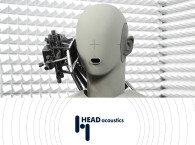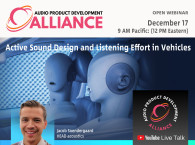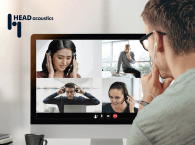
HEAD acoustics' 11-part seminar series began mid-March 2017 and ends at the end of May. The seminar sessions are in English and cover various topics such as voice quality metrics, double talk testing and noise suppression measurement techniques. The HEAD acoustics website provides links to register for the sessions. Everyone interested in audio and speech quality is welcome to join the webinars and to take advantage of this unique offering.
The web seminar series will allow attendees to better understand the basics of the human ear, the physics of hearing and how it impacts Voice Quality testing, while detailing essential aspects of analysis techniques. It covers essential topics such as Head Related Transfer Function (HRTF), the dynamic nature of human hearing (frequency and level), basic frequency analysis techniques, and different source signals (and standards) used for Voice Quality testing.

Upcoming seminars include:
April 5 - Speech Transmission & Intelligibility Index Metrics
In speech communication, many different metrics can be used to quantify ‘good’ and ‘bad’ performance. Voice is a very difficult signal to analyze and things like background noise, reverberation, echo and room acoustics can have a huge influence on how that voice is understood and interpreted.
Topics to be covered include:
Introduction and overview of common metrics
The test methods and how they are applied
Relating Indexes to practical intelligibility and Voice Quality
April 12 - Basic Voice Quality Metrics
When testing Voice Quality, many different metrics can be used to quantify ‘good’ and ‘bad’ voice quality. Given that voice is a very difficult signal to analyze, many different metrics have been developed over time to characterize the different aspects of voice signals. In Voice Quality testing there are a core set of metrics that all standards and industries use to measure specific parts of voice signals: Delay, Loudness Ratings, Frequency Response, Idle Channel Noise, Distortion, and Echo.
Topics to be covered include:
Introduction to the core Voice Quality metrics
Understanding of what each Voice Quality metric is trying to quantify
Relating basic Voice Quality metrics to specific voice quality issues
April 19 - Echo Testing: Basic to Advanced
Echo has been identified since the beginning of voice communications as one of the most annoying impairments that users can encounter. Nothing can end a phone call faster than persistent echo! Since echo is such a nuisance, there are many different ways to characterize echo and understand how an echo canceller is performing.
Topics to be covered include:
What is echo?
How does delay affect echo?
Review of different metrics (basic to advanced) used to characterize echo
April 26- Double Talk Testing
In a normal, live conversation between individuals it is natural that some double talk occurs. In voice communication systems ensuring that double talk can seamlessly occur is a very difficult thing to do. Processing issues such as delay, device response time, voice activity detection (VAD), and many others can make real-time two way communication almost impossible.
Topics to be covered include:
What is double talk?
Why is double talk an important metric?
Review the different analysis techniques used to quantify double talk
May 3 - Mean Opinion Scores (MOS)
One of the main goals of many Voice Quality test programs is to come up with a single, easy to interpret metric that can provide information about how ‘good’ or ‘bad’ a voice signal. As discussed in previous web seminars, it is not easy to objectively quantify voice; therefore, many other metrics have been introduced that try to analyze specific Voice Quality attributes. In recent years both technology and methodologies have been introduced that can now calculate such a single metric which is referred to as a Mean Opinion Score, more commonly referred to as a MOS.
Topics to be covered include:
Introduction to MOS
What is the difference between Subjective and Objective MOS?
How does an Objective MOS metric relate to a Subjective MOS metric?
Review of commonly used MOS metrics in modern Voice Quality testing
May 10 - Noise Suppression Measurement Techniques: Part 1
As DSP technology has become more cost effective to deploy, it has become possible for communication devices to utilize this power to actively suppress background noise in voice calls. This has improved the quality of voice calls significantly in recent years provided the noise suppression techniques only reduce noise and not affect the voice. Quantifying how much noise suppression has been applied and evaluating its impact on voice quality is important to ensure that the voice call is indeed better with noise suppression, not worse.
Session 1 will cover:
Why is Noise Suppression Important?
Using single value calculations to quantify noise suppression: D Value, Acoustic Noise Rejection (ANR), and SNRi (Signal to Noise Ratio Improvement per ITU G.160)
May 17 - Session 2 will cover:
Evaluating noise suppression using 3QUEST
What are the differences between ETSI ES 202 396-3 and ETSI TS 103 106
Background Noise Transmission (BGNT) techniques
May 24 - Noise Simulation Methodologies
Modern communication devices can be exposed to a wide variety of background noises that can stress a noise suppression system in many ways. In order to properly test a noise suppression system it is desirable to expose devices to a wide variety of background noises. But in order to ensure that two tests are done comparably, it is important that the background noise is accurate and repeatable. If that device is not exposed to such a background noise, then it is very difficult to quantify the noise suppressor’s performance in a meaningful way.
Topics to be covered include:
Review of the popular ETSI ES 202 396-1 standard to reproduce background noise using a diffuse sound field approach
Introduction to the new ETSI TS 103 224 standard for sound field simulation
Differences between the two ETSI methodologies
Ways to verify the accuracy and reproducibility of background noise simulations
Check HEAD acoustics website for the complete webinar schedule and registration.
www.head-acoustics.de/eng/training_center_telecom_webinars.htm






